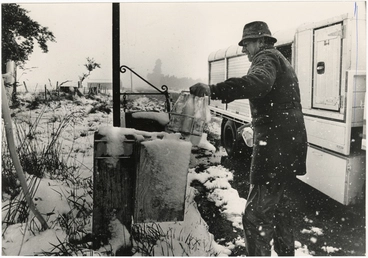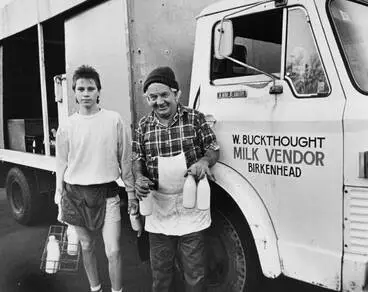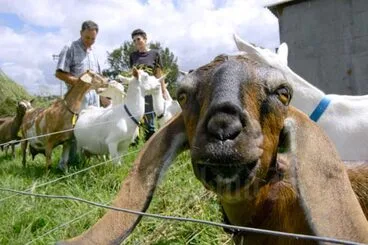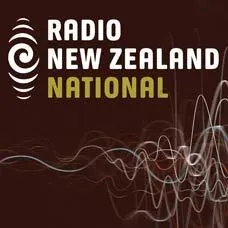From milkmaids to machine milking of cows
A DigitalNZ Story by Zokoroa
From hand to machine milking of cows, which also led to the milking of goats and sheep in NZ
Milk, Milking, Hand milking, Machine milking, Cheeses, Butter, Dairy cows, Cows, Dairying, Sheep, Goats, Factories, Farmers, Milk delivery, Inventions, Vegan, Veganism, Plants
In the early days, dairy cows were hand milked, usually by women (often called milkmaids) and children. The milk was collected in buckets and processed in the farm kitchen. Milking machines were first introduced in the 1890s which led to changes in the design of farm sheds and the introduction of factories to produce milk, butter and cheese. The herringbone shed design was invented in 1952, followed by rotary machine milking in 1962.
Over the decades, goats were also raised by some farmers for their milk as well as for meat and fibre. During 1992, a milking breed of sheep, the East Friesian, was imported from Sweden for a breeding programme. The results have led recently to an increased interest by farmers to milk sheep for the export market. An alternative to milk from dairy cows, goats and sheep is plant-based milk, which has a growing market impacting on the dairy industry.
Hand milking dairy cows which was generally the task of women & children
A lady milking a cow outside while another lady holds a child standing by the gate, 1894
Auckland Libraries
This boy is milking a cow by hand inside a shed (1903). Cow's leg is tied & the boy is sitting on a wooden stool.
Child milking a cow, 1903
Manatū Taonga, the Ministry for Culture and Heritage
Milkmaid carrying a pail & resting hand on a cow, c. 1919-1935
Milkmaid with cow
Alexander Turnbull Library
Milking machines were first introduced in mid-1890s
(Photo: Milking machine on an Auckland farm, c. 1900-1909)
Auckland Libraries
Herringbone shed design with cows machine-milked on either side of a pit was invented in 1952
(Photo: Herringbone Milk Shed at Matamata, Nov 1971)
Archives New Zealand Te Rua Mahara o te Kāwanatanga
Rotary machine milking introduced in 1962 and by the early 2000s over 100 cows could be milked at once
(Photo: Cows hooked up to a rotary milking machine, Kaponga, Taranaki, 1982)
Archives New Zealand Te Rua Mahara o te Kāwanatanga
NZ's dairy goat industry has also developed since 1990s to produce milk for a range of uses
By 2005, c.40,000 goats provided milk for milk powder, nutritional drinks, cheeses & health products (eg soap)
Alexander Turnbull Library
Sheep milk production increased following the importation of East Friesian sheep from Sweden in Dec 1992
(Photo: A flock of East Friesian ewes being milked on a farm near Masterton, 2003)
Manatū Taonga, the Ministry for Culture and Heritage
Backstory:
The following is a pictorial description of:
1. Milking of dairy cows over the decades
2. Milking of goats
3. Milking of sheep
4. Plant-based milk
>>>>>>>>>>>>>>>>>>>>>>
1. MILKING OF Dairy cows OVER THE DECADES
a. DAIRY COWS arrived IN NZ from 1814
On 22 Dec 1814, dairy cows arrived with Rev Samuel Marsden for Oihi Mission in Bay of Islands
Animals on board included one bull & two Durham dairy cows (Shorthorns), which were thought to be the first cattle in NZ
National Library of New Zealand
By the early 1840s, shorthorn herds were established & settler families had 1 or 2 cows to provide for their dairy needs
MTG Hawke's Bay
Settler farmers grazed the cows on pastures cleared of native bush
Photo: A group of dairy cows fenced inside an enclosure which has been clear felled of trees, c.1890s
Alexander Turnbull Library
Photo: Cow being milked at Pukearuhe Armed Constabulary Station, c.1869-1870
Thomas Potter Lister's house, Pukearuhe Armed Constabulary Station
Puke Ariki
Photo: Clover the dairy cow with a milking stool and a pail nearby, c.1890
Nellie with Clover the cow
Alexander Turnbull Library
Photo: Hand milking at a maternity home in Greytown, 1897
Mrs Fuller behind maternity home
Wairarapa Archive
A dairy farm at Auroa Road, Awatuna, South Taranaki, 1890
Dairy farm, Auroa Road, South Taranaki
Puke Ariki
Cow's milk was used to provide fresh milk, butter and cheese
The milk was strained through fine mesh, then allowed to settle so the cream rose to the top
The cream was skimmed off with a ladle
National Library of New Zealand
The cream was made into butter in a small churn
(Photo: A butter churn with a circle of dovetailed wooden slats, bound by two metal hoops, c.1880-1900)
Puke Ariki
A large, square, tabletop butter churn with an internal beater
There is also a small hole under the handle which would have allowed for buttermilk to be drained from the churn
Te Hikoi Museum
A hand operated butter churn used for farmhouse manufacture of butter in the 1800s - early 1900s
The churn would hold around 40 pounds of butter. (Photo: 1899)
Palmerston North City Library
A pair of wooden butter pats were used to press water out of churned and washed butter and to shape it
Te Hikoi Museum
Butter moulds or stamps were used to shape freshly-churned butter into dainty shapes for the table
Museum of New Zealand Te Papa Tongarewa
Electroplated dome shaped lid which sits on a bowl of silver-plate used to keep butter cool
Photo: 1866-1899
Teviot District Museum
During 1880s, a cream separator began to be used by farmers to separate cream from their milk
The centrifugal separator had been invented by the Swedish engineer Gustaf de Laval which he patented in 1878
Victoria University of Wellington
A family's surplus butter would be taken to the local store & swapped for food or farm tools
The storekeeper would then sell the butter
Wyndham & Districts Historical Museum
B. FIRST CO-OPER ATIVE Cheese Factory, 1871
In 1871, the first factory-style dairy processing operation began in New Zealand. Eight neighbouring farmers formed the Otago Peninsula Co-operative Cheese Factory Co. Ltd at John Mathieson's farm at Springfield. They made Dunlop cheese from Ayrshire milk which they initially sold in Dunedin and then exported to Australia.
Find out more: Karen Trebilcock, "150 years of dairy co-operation", NZ Farm Life Media, Sept 2021
In 1871, the Otago Peninsula Co-operative Cheese Factory Co, Ltd was formed by 8 neighbouring farmers at Springfield
They set up the first factory-style dairy processing operation in NZ & made Dunlop cheese from Ayrshire milk
Massey University
The cheesemaking factory was at John Mathieson's "Springfield" homestead until he withdrew from the company in 1875
Kitchen (facing left of centre) heated tubs of whey & the barn was the factory (stone-walled building at rear)
Massey University
Dunlop cheese was made from Ayrshire milk. It was initially sold in Dunedin & then exported to Australia.
A wooden vat (100 gallons milk) was in the barn & 3 enamelled cast-iron tubs (each held 50 pounds curd) in the kitchen
Massey University
In 1875, the factory shifted to a brick building at Highcliffe, & became known as the Peninsula Cheese Making Company
Further name changes occurred: Peninsula Pioneer Cheese Making Company (1879), & Pioneer Cheese Making Company (1883)
National Library of New Zealand
On 15 Aug 1884, the Company became the Taieri and Peninsula Milk Supply Company of Dunedin Ltd
It switched from cheese-making to supplying milk to Dunedin
National Library of New Zealand
C. DAIRY FACTORIES, 1880S -
In April 1881, English colonist William Bowron delivered a lecture on the advantages of cheese & butter factories
The lecture was organised by the Agricultural and Pastoral Association
National Library of New Zealand
Bowron's lecture led to the opening of the 2nd dairy factory in NZ - the Flemington Dairy Company at Ashburton in 1882
Factory was managed by William Harding, whose father Joseph is credited with making modern Cheddar in Somerset in 1850s
Massey University
In 1882, Bowron was appointed Government Inspector of Dairy Produce Factories
He published pamphlets & facilitated the setting up of dairy factories across NZ until his death in 1890
National Library of New Zealand
In 1881, first purpose-built factory was built (Edendale Dairy Factory) & by 1884 twenty-four factories had been built
The 24 factories were initially in the Waikato & Taranaki. (Photo: Edendale Dairy Factory which had insulated walls)
Wyndham & Districts Historical Museum
In Jan 1882, the Edendale factory produced its first batch of cheese:
"Thomas Brydone came up with the idea that if the Land Company were to build a cheese factory and purchase a herd to start it, that settlers would be attracted to take up sections. Davidson on a tour to Canada gained blueprint plans for a model factory which was in 1881 in the process of being constructed under the supervision of Thomas Brydone and the Edendale Estate Manager Robert McCallum. In January 1882 the first batch of cheese was in the press. The factory cost 1,200 pounds but won a government bonus of 500 pounds in the second season of production. Built of wood by Thomas Robertson, it was 40 feet by 65 feet and fitted with ‘all the modern appliances for butter and cheese making. Robert McCallum supervised and employed Mr George Inglis, his wife, and daughter to carry out the work and feed the pigs. The factory was supplied by cows owned by the Company and produced 560 gallons with 150 gallons supplied by surrounding farmers. The cows were milked by women and boys who were paid 1 penny per cow. 150 Berkshire pigs were kept to consume the whey."
Source: Wyndham & Districts Historical Museum: Photograph, Edendale Dairy Factory 1882)
In 1882, when NZ's 1st successful shipment of frozen meat went to Britain, a small amount of Edendale butter was aboard
A coal-powered Bell Coleman freezing plant cooled the ship's hold to 22 degree celsius below outside temperature
Manatū Taonga, the Ministry for Culture and Heritage
On 3 Nov 1886, Anchor butter was launched at Pukekura, Waikato by Henry Reynolds
Reynolds allegedly named his brand of butter 'Anchor' after seeing a tattoo on the arm of one of his employees
Archives New Zealand Te Rua Mahara o te Kāwanatanga
The butter recipe used was developed by American, David Gemmell, who was farming in the Waikato
Reynolds arranged for Gemmell to help establish his factory before Gemmell returned home to US. (Photo: 1910-1920)
Auckland War Memorial Museum Tāmaki Paenga Hira
Often farmers would collect & transport their milk to small packing stations for blending for local sale as butter
(Photo: Ambury, English & Company's creamery and butter factory opened in Greenwood Road, Māngere, c.1895)
Auckland Libraries
Several dairy factories also cooperatively owned
By 1890, there were 150 dairy factories throughout New Zealand of which 40% were cooperatives owned & managed by farmers
(Photo: Waitara Taranaki Co-operative Dairy Company, Limited's factory building, 1884)
Massey University
Milk being delivered to the Norsewood Co-operative Dairy Company in a horse-drawn scandi wagon
Norsewood Co-operative Dairy Company, Limited. Milk delivery by scandi wagon, 1890s
Massey University
Milk deliveries at Reynolds & Company Factory, one of the creameries operated by Moa Farmers’ Cooperative Dairy Co.
Moa Farmers' Co-operative Dairy Company, Limited. Reynolds and Company Factory milk delivery, 1893
Massey University
Five horse-drawn delivery carts carrying milk churns in front of the Hukanui Creamery
Hukanui Creamery with delivery carts : digital image
Wairarapa Archive
Horse and cart with containers at butter & cheese factory at Temuka
Temuka, Geraldine County, Canterbury, showing Butters & Cheese factory and horse and cart with [milk?] containers
Alexander Turnbull Library
Babcock milk testers were imported in 1892 to measure fat content to prevent watering down milk to increase volume
It was used at the Pukekohe Dairy Factory. Tests showed the fat content of milk was 3–4%.
Waikato Museum Te Whare Taonga o Waikato
D. Milking machines, 189os -
During the 1880s, milking machines began to be increasingly used in the United States and Europe, including Scottish models, leading to trials in NZ in 1892. Five years later, the first milking machines from the Cunnington Pulsator Milking Company, Christchurch were installed in 1897. Cups were attached to the cow’s udder, and the milk was collected into buckets.
"Four of these machines were set up in the Rongotea area by Mr Holben. The first four farmers were Samuel Knight, Fred Richmond, Carl Anderson and A Broadbelt. These four Rongotea farmers were the first in New Zealand to install milking machines. The installations were made by Mr E R B Holben of Palmerston North on behalf of the Cunnington Pulsator Milking Machine Company, Christchurch. This was before the introduction of oil engines and so one was driven by man power, two by treadmills and one by a steam engine. It was not long afterwards that suitable internal combustion engines were introduced and mechanical milking became accepted practice. The body of one of these machines was used as a water trough on T G Gloyn's farm (Avalon Banks Line) until it rusted out about 1960."
Source: Palmerston North City Library, Mr Holben with the First Milking Machine in New Zealand)
During 1880s & early 1890s, milking machines were patented overseas & increasingly used in US & Europe
NZ newspapers began reporting on overseas trials, including Scottish inventions in 1892, which led to trials in NZ
National Library of New Zealand
In Sept 1892, a milking machine was trialled at Robert Wallace's farm in Māngere, South Auckland
National Library of New Zealand
Milking machine: Cups were attached to the cow’s udder, and the milk was collected into buckets
Milking machine
Te Awamutu Museum
In 1897, the first 4 milking machines were installed from the Cunnington Pulsator Milking Machine Co., Christchurch
The machines were in the Rongotea area: One was driven by man power, two by treadmills & one by a steam engine
Palmerston North City Library
Vacuum and pulsation was applied through four teat cups (called a cluster) attached to the cow’s udder
The pulsator started & stopped, allowing teat to fill up again, instead of a continuous vacuum to squeeze out the milk
National Library of New Zealand
E. Skimming stations, 1890s -
By the end of the 1890s, small skimming stations began to be built to reduce travel distances for farmers to the milk factory.
Find out more: Hugh Stringleman and Frank Scrimgeour, 'Dairying and dairy products - Cooperatives and centralisation', Te Ara - the Encyclopedia of New Zealand, http://www.TeAra.govt.nz/en/dairying-and-dairy-products/page-3
By end of 1890s, small skimming stations began to be built to reduce travel distances for farmers to the milk factory
(Photo: Milk deliveries to Otakau Dairy Factory - a skimming station of Taieri & Peninsula Milk Supply Company, Dunedin)
Massey University
The farmers could take milk each morning to the skimming stations which would separate the cream to make butter
Photo: Skimming station owned by J Nathan & Co. Ltd. who supplied cream to their butter factory at Makino, near Feilding
Palmerston North City Library
The milk was weighed & then poured into separators to extract the cream & then the cream taken to dairy factory
Photo: Douglas Road Creamery which was a skimming station for Crown Dairy Factory Company
Massey University
A creamery with separators at work, 1893
A portion of the skim milk was returned to the farmer to feed pigs & calves
Auckland Libraries
Oil was poured into the separator's frame before using; topped up weekly & replaced after 6 months
Wyndham & Districts Historical Museum
The cream from a number of farms was then transported to the central dairy factory
Photo: Bunnythorpe Skimming Station which sent cream to "Black Swan" butter factory in Palmerston North, 1893
Palmerston North City Library
Alternatively, farmers used their own centrifugal separator & the cream was then sold to cream factories to make butter
Remaining portion of milk went to dairy factory (Photo: Crown Dairy Factory Co. Ratanui Cheese Factory, c.1896 to 1898)
Massey University
Crown Dairy Factory Company. Moutoti Creamery, c.1898-1906
Crown Dairy Factory Company. Moutoti Creamery, 1898 to 1906
Massey University
Ayrshire cow which won the first prize in milk at the Canterbury Agricultural and Pastoral Show, 1894
Mr H Laing's Ayrshire Cow, Cherry 2nd (in milk) - First Prize, Canterbury
Auckland Libraries
In 1894, the Dairy Industry Act was introduced
Goods were graded for export & payment for milk was based on factory inspection
The University of Auckland Library
F. Scenes from 1900s - 2000s
1900s
During the 1900s, some farms continued with hand milking, whilst others began using machines to milk their dairy cows.
c.1900s: Hand milking continued at the Smith farm on the main road at Uruti, Taranaki
Farmer's daughters doing their share of milking
Auckland Libraries
A lady holding a small stool and a bucket ready for hand milking, 1903
The old method
Auckland Libraries
Scene, including milking cows, at a Paeroa farm, 1900-1909
Mr Marsh's farm at Paeroa- New Zealand farm scene
Auckland Libraries
A woman hand milking Jersey cows at Tamahere near Hamilton, 1907
Milking the jerseys
Auckland Libraries
Hutchinson non-suction milking machine showing milk jets coming from four teats & running from tray into bucket, c.1900s
Hutchinson non-suction milking machine showing milk jets coming from the four teats of a cow and running from tray into bucket
Auckland Libraries
A row of men hand milking cows in milking shed (no date)
Photograph of Men in Milking Shed
Te Aroha & Districts Museum
Children operating the bush churn, 1900-1909
DAIRYING IN THE BACK BLOCKS OF NEW ZEALAND: OPERATING THE BUSH CHURN
Auckland Libraries
A row of cows, each with back leg tied to post, being milked by a Rudd machine, 1909
Cows being milked by a Rudd machine
Alexander Turnbull Library
The Kiora creamery, Makauri, Gisborne, c.1900s
The Kiora creamery, Makauri, Gisborne
Auckland Libraries
A barrow built by a farmer to cart milk cans from milking shed to a vehicle for transport to the Oware Dairy Factory
Barrow, Milk Can
Wyndham & Districts Historical Museum
Transport to factories included horse-drawn carts
Men loading horse-drawn carts with milk cans ready for transport to a factory in the Taranaki district, c.1900
Alexander Turnbull Library
In Waikato and Northland, river boats & barges also used to carry milk & cream to factories
Photo: Launch delivering milk from the farms on the river bank to the Mercer creamery, c.1900s
Auckland Libraries
Horses delivering milk to the Reikiorangi Skimming Station near Waikanae, 1902
Skimming Station
Palmerston North City Library
Paeroa creamery built by New Zealand Dairy Association in 1899 was purchased by Thames Valley Co-operative in Aug 1901
Paeroa creamery
Manatū Taonga, the Ministry for Culture and Heritage
Boiler is housed in a separate building in front of the Makuri Creamery, c.1900-1902
Crown Dairy Factory Company. Makuri Creamery, Toko, 1900 to 1902
Massey University
In 1902, the first radiator dairy factory in NZ erected on Messrs Bagnall Bros Turua estate near Thames
Auckland Libraries
In 1904, J C Nathan started a small milk powder plant at Bunnythorpe, trading under the name Defiance
Joseph Nathan and Co. Ltd dried milk factory, Bunnythorpe
Palmerston North City Library
Interior of dried milk factory at Bunnythorpe
Interior of dried milk factory, Bunnythorpe
Palmerston North City Library
1905: Vehicle with 8 horsepower double cylinder petrol engine owned by Avonbank Dairy, Burwood, near Christchurch
An up-to-date dairyman's turn-out
Christchurch City Libraries
1907: Pakuranga farmer/carrier transferring milk from his farm for delivery to the town milk supply at Ellerslie
Albert Martin Mattson transfering milk from his farm to his son's wagon
Howick Historical Village
c.1907: After skim milk & cream separated at a creamery, the cream was transported to Rukuhia factory for making butter
Dairy factory at Rukuhia, Waikato, around 1907
Manatū Taonga, the Ministry for Culture and Heritage
Packing butter at the Paeroa Dairy Factory, 1900-1909
Interior of the Paeroa Dairy Factory: Packing butter
Auckland Libraries
c.1900-1909: Farmers delivering milk to Dairy Factory weighing and testing room
New Zealand Dairy Industry: Farm and Factory Views
Auckland Libraries
Taking milk sample at the cheese factory
Cheese Manufacture
Archives New Zealand Te Rua Mahara o te Kāwanatanga
c.1900-1947: Entering milk weights on test report sheets
Herd Testing
Archives New Zealand Te Rua Mahara o te Kāwanatanga
Bulk milk before being made into cheese
Cheese Manufacture
Archives New Zealand Te Rua Mahara o te Kāwanatanga
Vats at Waitoa Dehydrated Milk Factory
Receiving vats at Waitoa Dehydrated Milk Factory
Archives New Zealand Te Rua Mahara o te Kāwanatanga
In 1908, Nathan's firm, using the trade name of Glaxo, introduced new baby food into the NZ & British markets
Glaxo in London
Manatū Taonga, the Ministry for Culture and Heritage
1908: the Dairy Industry Act required the registration of dairy operations with the office of the Inspector of Stock
The University of Auckland Library
1909: Herd testing began at the Dalefield Dairy Company, Wairarapa
For the Babcock test to measure fat content of milk, milk samples were collected from each cow at each milking
Auckland Libraries
1910s
By 1918, 24,700 farms (71%) supplied cream to dairy factories. (Source: Hugh Stringleman and Frank Scrimgeour, 'Dairying and dairy products - Separators and milking machines', Te Ara - the Encyclopedia of New Zealand, http://www.TeAra.govt.nz/en/dairying-and-dairy-products/page-4
Hand milking cows in a shed, c. 1910s
Hand milking cows in a shed, probably Christchurch
Alexander Turnbull Library
Cows were tied by a leg-rope & hand milked by men sitting on box-stools in this shed which had about 15 stalls, 1910
Milking Shed - Pohangina Valley
Palmerston North City Library
Children hold their milk pails on a dairy farm in 1910. Children often had chores before going to school.
Milk boys
Manatū Taonga, the Ministry for Culture and Heritage
A new Glaxo milk powder factory opened at Matamata in 1917
New Glaxo factory at Matamata
Auckland Libraries
Milk transferred to carts from a launch on the Tamaki River, Auckland for delivery to dairy factory, c.1910s
With the man on the land
Auckland Libraries
Pakuranga farmer transporting cream cans with horses and cart, c.1910
Mattson's milk, Pakuranga, circa 1910
Auckland Libraries
Bullock-drawn wagon taking milk to Timaru Skimming Station at Tataraimaka, part of Oakura Co-operative Dairy Co., c.1910
Patua Co-operative Dairy Company, Limited. Milk supplier, circa 1910
Massey University
Patua Co-operative Dairy Company, Limited. Timaru Creamery at Tataraimaka, c.1910
Oakura Co-operative Dairy Factory Company, Limited. Timaru creamery, Tataraimaka, circa 1909
Massey University
NZ newspaper article shows milk out of a vending machine invented in Portsmouth for when dairy is closed, 1913
Put a penny in the slot - a dairyman's novel idea
Auckland Libraries
Mattson's milk delivery lorry at Pakuranga for Auckland Farmers Co-operative Milk Supply Company Ltd, c.1915
Milk delivery lorry, Pakuranga, circa 1915
Auckland Libraries
Five delivery carts by the Hukanui Creamery, c. 1896-1915
Hukanui Creamery : digital image
Wairarapa Archive
Otaki Dairy Company. Te Horo Branch interior, c.1916
Otaki Dairy Company. Te Horo Branch interior, circa 1916
Massey University
Hand milking still continued on some farms. (Photo: Stockman is hand milking, c.1917)
Stockman milking
Auckland War Memorial Museum Tāmaki Paenga Hira
Second photo: Loading cheese for export at Wellington, 1910-1919.
Our sea-borne commerce - busy scenes round the Wellington wharves
Auckland Libraries
1920s
By 1920, there were 600 dairy processing factories of which about 85% were owned by co-operatives
(Photo: Tamaki Co-operative Dairy Company, Limited. Factory at Te Rehunga after being rebuilt from 1923 to 1924)
Massey University
Women working on a Waikato dairy farm, 1920-1929
Doing A Man's Job and Doing It Well: Happy Girl Workers on A Waikato Dairy Farm
Auckland Libraries
Onehunga Dairy, 223 Queen Street, Onehunga, with signs advertising milk, c.1920
Onehunga Dairy, Queen Street, Onehunga
Alexander Turnbull Library
Milk cooler on Aplin's farm, Silverstream, c.1921
Milk cooler on Aplin's farm, Silverstream, circa 1921.
Alexander Turnbull Library
A large hand operated cream separator which would have been used to separate cream from fresh milk, c.1920-1950
Separator, Large Cream
Wyndham & Districts Historical Museum
A Sharples machine which separated cream from whole milk at the Bunnythorpe factory, 1920
Glaxo Manufacturing Company (NZ), Limited. Separator, Bunnythorpe factory, 1920
Massey University
By 1922 the 1st cooperative herd-testing scheme was underway in Waikato & expanded to 30 schemes in NZ four years later
Cast iron kit which tested the milk of each cow in a dairy herd for genetics & production details, c. 1920s-40s
Wyndham & Districts Historical Museum
Herd testers were often women & they travelled from one dairy farm to the next
The tester arrived in time for the afternoon milking & stayed overnight for the morning milking at 5.30am-6am
Manatū Taonga, the Ministry for Culture and Heritage
Milk delivery truck of L M Monk, Makara, 1923
Milk delivery truck of L M Monk, Makara
Alexander Turnbull Library
In 1923, NZ Dairy Control Board was formed to control group marketing, with Govt assuming product marketing in 1934
The Board was formed under the Dairy Produce Export Control Act 1923 & was owned by all dairy companies
Hamilton City Libraries
City milk supply laboratory, probably Wellington, 1925
City milk supply, laboratory, probably Wellington
Alexander Turnbull Library
Truck driver checks weight of milk cans
Truck driver checks weight of milk cans
Archives New Zealand Te Rua Mahara o te Kāwanatanga
Trucks lined up to collect steam cleaned milk cans after the milk was emptied and weighed at Mataura Dairy Factory, 1927
Photograph, 7 of 19, Mataura Dairy Factory Album [Farmers' Trucks]
Mataura Museum
The separator room in the milking shed of the Massey Agricultural College Dairy Building in 1928
Separator Room in Milking Shed, 1928
Massey University
The main Glaxo laboratory based in Hamilton which was dismantled & moved from Palmerston North in 1920 (Photo: c.1928)
Glaxo Manufacturing Company (NZ), Limited. Laboratory, Hamilton, circa 1928
Massey University
Milking by hand still continued on some farms (Photo: c.1920-1929)
The old-time method: milking by hand
Auckland Libraries
1930s
Walk-through shed. A chain behind the cow prevented it backing out & one leg tied to prevent kicking milking cups.
Walk-through milking shed
Manatū Taonga, the Ministry for Culture and Heritage
Photo: Farmer attaching milking cups to a dairy cow in a milking shed with electric milking capacity, c.1939
Farmer milking cows by machine - Photograph taken by H Drake
Alexander Turnbull Library
A metal plate for skimming cream from milk by trapping cream when milk ran through small holes in the plate, c.1930
Cream Skimmer
Waikato Museum Te Whare Taonga o Waikato
A hand-cranked butter churn, c. 1930-40
Blow Butter Churn 2/20
Waikato Museum Te Whare Taonga o Waikato
Pamphlet promoting milk for children, 1930
Wellington (N.Z.). Milk Committee: Wellington's municipal milk. Introducing to the citizens of Wellington some information re its milk supply [ca 1...
Alexander Turnbull Library
In 1931, the New Zealand Dairy Board was established & operated as sole export marketer
Photo: Promotional material NZ produces six times more butter & twice as much cheese since the last War, c. 1927-1935
Alexander Turnbull Library
During 1930s & 40s, a cream truck would collect cans every one to two days & return empty ones to each farm
Twenty gallon cans of milk being loaded from the farm dairy for delivery to the cheese factory
Archives New Zealand Te Rua Mahara o te Kāwanatanga
A pasteurising and cooling unit made of stainless steel, 1935
Wellington's milk supply is received, pasteurised and bottled m the Municipal Milk Depot. The photograph shows a pasteurising and cooling xinit mad...
National Library of New Zealand
SInce 1934, records of offspring of a cow & the bull parent have been kept
The aim was to breed the best stock & to research methods of artificial insemination
National Library of New Zealand
in 1936, the Herd Improvement Council was formed to improve the standard of cattle in the dairy industry
Three years later, 28 Herd Testing Associations were amalgamated into six herd improvement associations
National Library of New Zealand
From 1937 to 1967, primary school children received a free half pint of milk each day
See DigitalNZ story: Milk at schools
DigitalNZ
In 1937, the Sharemilking Agreements Act was passed
There were increasing occurrences of farm owners working with a 'sharemilker' who owned all or part of the herd
National Library of New Zealand
Milk reception stage and milk and cream treatment plant, 1938
Milk reception stage and milk and cream treatment plant at the Wellington City Corporation Milk Department's reorganised Rahui factory. (Evening Po...
National Library of New Zealand
Machine at Wellington Municipal Milk Depot cleans & fills the bottles in one operation, 1939
Evening Post" Pfcoto. This machine, recently installed at the Wellington Municipal. Milk Depot, cleans and fills the bottles in one operation. The ...
National Library of New Zealand
On 10 Oct 1935, Wellington's first milk bar opened - the Tip Top Milk Bar - & sold ice cream & milkshakes
Interior view of the Tip Top Milk Bar on the corner of Manners and Cuba Streets, Wellington, c.1930s
Alexander Turnbull Library
The popularity of the milk bar led to five others soon opening in Wellington and one in Dunedin
Kiwi Milk Bar on the corner of Manners and Herbert (now Victoria) Streets, c.1930s
Alexander Turnbull Library
The Golden Gate Milk Bar in Courtenay Place, Wellington, 1940
The Golden Gate Milk Bar
Manatū Taonga, the Ministry for Culture and Heritage
Milk drying machines used by Joseph Nathan and Sons, and the later Glaxo Manufacturing Company (N.Z.), Ltd
Glaxo Manufacturing Company (NZ), Limited. Drying room at the Bunnythorpe factory, after 1936
Massey University
Glaxo Laboratories was formed in 1937
The factory continued operating until 1973, when Glaxo shifted to Palmerston Nth
Palmerston North City Library
1939: New plant for cleaning, filling, & bottling milk at the Municipal Milk Depot
A most up-to-date plant for cleaning, filling, and bottling milk was recently brought into use al the Municipal Milk Depot in Tory Street. After pa...
National Library of New Zealand
1940s
From 1940s, milk began to be pasteurised
c.1940s: Raw milk being delivered to the factory for pasteurisation
Archives New Zealand Te Rua Mahara o te Kāwanatanga
Milk was heated, killing bacteria that can cause food poisoning & make milk deteriorate or "go off"
c.1940s: Bottling machine for pasteurised milk at Wanganui
Archives New Zealand Te Rua Mahara o te Kāwanatanga
Pasteurised milk poster, 1940s
Alexander Turnbull Library
The four men have been posed to show different stages in the butter making process, 1940s
Four men making butter
Alexander Turnbull Library
The pharmaceuticals packing room at the Glaxo Laboratories at Bunnythorpe factory, 1941
Glaxo Laboratories (NZ). Pharmaceuticals packing room, Bunnythorpe, 1941
Massey University
Wartime milk delivery, corner Alpha Avenue and Normans Road, Bryndwr, Christchurch, 1942
Wartime milk delivery, corner Alpha Avenue and Normans Road, Bryndwr, Christchurch
Christchurch City Libraries
H. Svendsen & Sons milk delivery vans at Pukekohe, 1942
Milk vendors and vans, Pukekohe, ca 1942
Auckland Libraries
Milk being tested for butterfat content, c.1944
Testing milk for butterfat, Wellington Milk Department
Alexander Turnbull Library
Sunshine Glaxo baby milk powder tin packed in October 1947
Tin, Sunshine Glaxo Milk Food
Mataura Museum
Wooden blocks were cut to size for the polygon ends of cheese crates at Egmont Box Company, Tokoroa, c.1947
Egmont Box Company, Limited. Tokoroa factory. Loading for polygon cutting, circa 1947
Massey University
In 1941, NZ Dairy Board published 1st list of proven sires & a commercial artificial breeding programme began in 1949
The programme was a world first and began in the Waikato and Taranaki with training of technicians set up by LIC
Manatū Taonga, the Ministry for Culture and Heritage
1950s
In the 1950s, the herringbone milking shed was invented by Waikato farmer Ron Sharp
He was inspired by seeing angle-parked cars in Hamilton
Manatū Taonga, the Ministry for Culture and Heritage
Sharp called the design 'herringbone' as it looked like a fish skeleton when viewed from above
Manatū Taonga, the Ministry for Culture and Heritage
The pit alongside allowed the farmer to put on & remove the milk cups without bending down
Manatū Taonga, the Ministry for Culture and Heritage
The cows walk in and out by themselves, & more cows could be milked at once by fewer people
The Fletcher Trust
In 1951 the use of cream cans ceased when factories required whole milk for processing
Auckland Libraries
To replace use of milk cans, milk tankers were introduced to collect milk from farmers
Massey University
Glass bottles were used to deliver milk to households
Palmerston North City Library
New type of milk delivery truck at the factory
Alexander Turnbull Library
Milkmen would deliver glass bottles of milk to households who'd leave their empty bottles & coins at the gate
Wairarapa Archive
Milk bottle top
Museum of New Zealand Te Papa Tongarewa
Milk bottle top
Museum of New Zealand Te Papa Tongarewa
Cream bottle top
Museum of New Zealand Te Papa Tongarewa
The tin was manufactured by tin maker and tin printer Alex Harvey & Sons Ltd Auckland, c. 1950
Tin - Anchor Full Cream Milk Powder 1 LB
Waikato Museum Te Whare Taonga o Waikato
Sunshine Glaxo milk food tined milk powder made by Glaxo Laboratories (NZ) Ltd., 1958
Glaxo Milk Food
MOTAT
1960s
In the late 1960s, the rotary milking platform was invented by Taranaki farmer Merv Hicks
The turnstile design had a raised circular concrete or steel platform with 16 to 60 stalls
Manatū Taonga, the Ministry for Culture and Heritage
Rotary milking sheds have a large rotating platform, with single stalls for the cows to walk into
The platform rotates on wheels powered by electric motors
Manatū Taonga, the Ministry for Culture and Heritage
New 1800 gallon tanker that kept milk chilled at 40 degrees
Photo: The milk tanker being delivered to for the Palmerston North milk processing station, 1963
Palmerston North City Library
Patua Co-operative Dairy Company, Limited. Milk tanker, 1965
Massey University
Wharfies stacking boxes of New Zealand butter, 1960
Wharfies stacking boxes of New Zealand butter
Museum of New Zealand Te Papa Tongarewa
Leaflet about the new Anchor full cream milk powder, 1960s
Leaflet, Using Anchor full cream milk powder
Waikato Museum Te Whare Taonga o Waikato
Anchor full cream milk powder. made by the New Zealand Dairy Co-operative NZ Ltd, Hamilton, c.1964
Tin: Milk Powder
Canterbury Museum
An automatic decrater lifts bottles out of crates onto a conveyor to a bottle washing machine, at Taita, Sept 1965
Taita Milk Treatment Station
Archives New Zealand Te Rua Mahara o te Kāwanatanga
Dirty milk bottles are automatically fed into the huge bottle washing machine at Taita, Sept 1965
Taita Milk Treatment Station
Archives New Zealand Te Rua Mahara o te Kāwanatanga
A filling & capping machine (capacity 400 bottles per minute) at Taita, Sept 1965
Taita Milk Treatment Station
Archives New Zealand Te Rua Mahara o te Kāwanatanga
An automatic recrater which fills two crates at a time (a total of 46 pints of milk) at Taita, Sept 1965
Taita Milk Treatment Station
Archives New Zealand Te Rua Mahara o te Kāwanatanga
1970s
Dental health educational display of image of a bottle of milk, 1970s
Educational display image (dental health) - bottle of milk
Museum of New Zealand Te Papa Tongarewa
Increasingly, milk was bought from a local store rather than home delivered (Photo: 1972)
Mrs Janette Frost with bottles of milk
Alexander Turnbull Library
Option of home deliveries continued (Photo: Wellington region, 1975)
Girl delivering milk
Alexander Turnbull Library
At the Rainbow Valley Community, Golden Bay, which was formed in 1974, the house cows were hand milked
Milking at Rainbow Valley Community
Tasman District Libraries
Operator on the milk bottling machine at the Hutt Valley Milk Treatment Station, Lower Hutt, July 1974
Food - Milk Department
Archives New Zealand Te Rua Mahara o te Kāwanatanga
Cream bottling machine at the Hutt Valley Milk Treatment Station. Lower Hutt, July 1974
Food - Milk Department
Archives New Zealand Te Rua Mahara o te Kāwanatanga
Stirring a vat of curds and whey, Kaponga Cheese Factory, 1976
Fred Pullen, Kaponga Cheese Factory
Puke Ariki
This Danish made machine tests milk samples for % of fat & protein at Rangitaiki Plains Dairy Co., 1976
Food - Milk
Archives New Zealand Te Rua Mahara o te Kāwanatanga
Waxing Edam Cheeses at the Kiwi Dairy Factory, Hawera, Dec 1978
Agriculture - Dairy Factories - Cheese
Archives New Zealand Te Rua Mahara o te Kāwanatanga
1980s
Working at a vat in Greytown Co-operative Dairy Factory, c.1980
Making cheese at Greytown
Wairarapa Archive
Forklift moving gouda cheese at Greytown Co-operative Dairy Company factory, c.1980
Forklift moving gouda cheese at Greytown Co-operative Dairy Company factory
Wairarapa Archive
Tui Co-operative Dairy Company, Limited. Cheese Department vats, c.1983
Tui Co-operative Dairy Company, Limited. Cheese Department vats, circa 1983
Massey University
The cheese packing room at the Tui Co-operative Dairy Company cheese factory at Mangatainoka, c. 1983
Tui Co-operative Dairy Company, Limited. Cheese packing room, circa 1983
Massey University
Delivering milk in snowy conditions in Darfield-Springfield area, 28 Oct 1985
Delivering milk in the snow
Christchurch City Libraries
Cheddar cheese production, Kiwi Co-op Dairy Factory, Hawera, Oct 1986
Agriculture - Dairy Factories - Cheese
Archives New Zealand Te Rua Mahara o te Kāwanatanga
Cheddar cheese production, Kiwi Co-op Dairy Factory, Hawera, Oct 1986
Agriculture - Dairy Factories - Cheese
Archives New Zealand Te Rua Mahara o te Kāwanatanga
Cheese production at the NZ Co-op Rennet Co. factory at Eltham, Oct 1986
Agriculture - Dairy Factories - Cheese
Archives New Zealand Te Rua Mahara o te Kāwanatanga
The 600-ml glass bottles have aluminium-foil covers pressed into grooves near the top; no adhesive used (Photo: 1986)
Bill Jeffries, M P on a milk run with Joe Serci.
Upper Hutt City Library
In 1988, an LIC corporation is formed as a wholly owned subsidiary of the NZ Dairy Board
The six LIC associations were wound up
National Library of New Zealand
From August 1989, glass milk bottles were phased out & replaced with cardboard cartons
Image taken to capture the end of glass bottle deliveries, 8 July 1989
Auckland Libraries
1990s
Milk delivery person with a tetra pack milk carton & milk sachet, 1993
Milkman, Peter McCormick
MTG Hawke's Bay
Anchor milk delivery truck, Browns Bay, East Coast Bays
Anchor milk delivery truck, Browns Bay
Auckland Libraries
Glaxo Laboratories closed its operations in Palmerston North in 1995
Glaxo Laboratories
Palmerston North City Library
Plaque commemorates opening of Milk Powder Complex at the Southland Dairy Cooperative's Edendale Factory, 1995
Plaque, Opening of Milk Powder Complex Edendale
Wyndham & Districts Historical Museum
During 1996–97, herd-testing reached a peak when 2.5 million cows (90% of all cows) were tested
Testing services are provided by farmer-owned Livestock Improvement Corporation (LIC) & genetics company Ambreed
Manatū Taonga, the Ministry for Culture and Heritage
2000s
On 16 Oct 2001, NZ Dairy Board, Kiwi Co-operative Dairies Ltd & NZ Dairy Group merged as GlobalCo (later named Fonterra)
The merger was enabled under the Dairy Industry Restructuring Act 2001. LIC also became an user-owned co-operative.
Department of Internal Affairs
Westland Milk Products chose not to join the merger and remained as an independent dairy company
Manatū Taonga, the Ministry for Culture and Heritage
Tatua Co-operative Dairy Company also chose to remain as an independent company
Other manufacturers include Dairy Trust, Synlait, & Open Country Dairy
Manatū Taonga, the Ministry for Culture and Heritage
From 2001-2009, DairyNZ Greenfleld Project developed 1st automatic/robotic milking which was held near Hamilton
Cows on nearby pasture voluntarily walked to the milking shed once or twice in 24 hours & waited for their turn
National Library of New Zealand
During 2005/6 season about 2.8 million (70%) cows were tested by LIC & Ambreed
Testers visit a farm an average of 4x a year & sample milk from each cow which is sent to a laboratory for analysis
Manatū Taonga, the Ministry for Culture and Heritage
In 2011, a new milk powder dryer was commissioned at the existing Synlait Dairy, Dunsandel
Manatū Taonga, the Ministry for Culture and Heritage
By 2014 the dairy industry contributed 4% to the NZ’s GDP, & earned more than $10 billion in export earnings
Brands include Fernleaf, Anchor, Kapiti, Anlene, Anmum and Fresh ‘n Fruity
NZ On Screen
2019: Fonterra's Longburn Dairy Products Plant produces milk & mineral acid casein
Palmerston North City Library
3 Dec 2021: Fonterra raised its forecast milk payout to farmers to a record level $8.40 & $9 per kilogram of milk solids
Radio New Zealand
2. Milking OF goats
The first goats were thought to have been released in New Zealand by Captain James Cook on his second and third voyages during the 1770s. In 1839, a visitor to the whaling settlement on Arapawa Island wrote in his diary that it "swarmed" with goats. Over the decades, further goats were introduced by missionaries and settlers. The goats are farmed for their meat, fibre from their hair, and milk which is also made into cheese and health products such as soap. Nowadays goats are milked by hand or machine. In 2005 there were about 26,000 milking goats in the Waikato region, and about 40,000 throughout New Zealand. By 2018, there were approximately 85,000 goats supplying four companies producing milk powder, cheese and liquid milk.
Find out more:
- New Zealand Arapawa Goat Association: Arapawa Goat Timeline.
- Allan Gillingham, 'Goats and goat farming - Farming goats for weed control and milk', Te Ara - the Encyclopedia of New Zealand (24 Nov 2008), http://www.TeAra.govt.nz/en/goats-and-goat-farming/page-3
- Marjorie Orr, History of dairy goats in New Zealand. Rural News, 22 May 2020
- IGA (International Goat Association: Country Report: New Zealand Dairy Goat Industry (8/2/2018)
- New Zealand Dairy Goat Breeders Association, URL: https://www.nzdgba.co.nz/
Goats were raised for their meat and milk which is nutritious to drink & also used to make cheese
(Photo: Milking goats are penned in a paddock on a property in Swanson, 1958)
Auckland Libraries
Goats milk was also using for making soap
(Photo: Soap by Smith-Biolab Ltd, Auckland)
MOTAT
Specially designed sheds and equipment were used for milking goats
{Photo: Herd being milked near Wainuiomata in early 1980s. The milk was sold to local health shops.)
Manatū Taonga, the Ministry for Culture and Heritage
During economic downturn during early 2000s, some farmers diversified to keep goats
(Photo: Twenty goats on a small farm near Albany were milked to make speciality cheese)
Manatū Taonga, the Ministry for Culture and Heritage
Nowadays, goats are milked by hand or by machine
(RNS video (2016): Goats in a milking shed in Hamilton (0:55 min)
Radio New Zealand
RNZ video (21 Dec 2016): Goats milked in Kaikoura to produce cheese (2:41 min)
Kaikoura Cheese continued on through the quake
Radio New Zealand
A popular breed for milk is Saanen which originated in Switzerland
Manatū Taonga, the Ministry for Culture and Heritage
Other breeds include: Anglo-Nubian, Sable, Toggenburg, British Alpine & Nigerian Dwarf
Manatū Taonga, the Ministry for Culture and Heritage
3. milking OF SHEEP - RECENT TREND
The first sheep were introduced into New Zealand by Captain Cook in 1773 and 1777, followed by the arrival of other flocks with missionaries and settlers. By the 1850s, sheep had become an important export earner in wool and, later, in frozen meat from 1882 onwards. Sheep numbers peaked at 70.3 million in 1982, but had fallen below 26 million by 2021. (Source: Hugh Stringleman and Robert Peden, 'Sheep farming - Importance of the sheep industry', Te Ara - the Encyclopedia of New Zealand, http://www.TeAra.govt.nz/en/sheep-farming/page-1)
A milking breed of sheep, the East Friesian, was imported from Sweden in 1992. Eleven pregnant ewes and four rams were involved in a breeding programme which used embryo transfer techniques and artificial insemination at a quarantine station at Silverstream, near Dunedin. By early 2014, there were five dairy sheep operators in NZ and the size of the flocks ranged from 70 ewes to over 20,000 ewes in Invercargill at Blue River Dairy. Since then, there has been increased interest with more farmers looking at sheep milking as an export growth industry for cheeses, yoghurt, fresh milk, whole and skim milk powders, and infant formula products. As of June 2019, there were 18 commercial sheep dairy farms with the national flock totalling 12,345. (Source: Ministry of Primary Industries –Massey University. (2020). New Zealand Sheep Dairy Survey, July 2020, Wellington and Palmerston North: MPI-Massey University)
Find out more:
- Ben Schrader, 'Wairarapa region - A farming economy', Te Ara - the Encyclopedia of New Zealand (1 Mar 2017), http://www.TeAra.govt.nz/en/photograph/12088/milking-sheep
- New Zealand Sheepbreeders' Association: East Friesian, URL: https://nzsheep.co.nz/east-friesian/
- S.W. Peterson & C. Prichard (2015), "The sheep dairy industry in New Zealand: a review", Proceedings of the New Zealand Society of Animal Production, (Vol 75, pp. 119-126).
- Nadene Hall, "Why sheep might be the new cows", ThisNZlife, URL: https://thisnzlife.co.nz/why-sheep-might-be-the-new-cows-everything-to-know-about-the-growing-sheep-milk-industry/
The first sheep in NZ were amongst the animals that arrived with Captain Cook in 1773 & 1777
Later, flocks of sheep arrived with missionaries & settlers
Auckland Libraries
By the 1850s, sheep had become an important export earner in wool and, later, in frozen meat from 1882 onwards
(Photo: Painting titled 'Birchwood station on Mr Watts Russell's sheep run' by James Edward Fitzgerald, 28 Nov 1852)
Canterbury Museum
in 1989, Massey Univ research conducted on sheep milk for human consumption
(Photo: Sheep being milked for Massey research on type of milk yield & milk composition for human consumption, 1989)
Massey University
In 1992, East Friesian sheep were imported from Sweden to begin a breeding programme to produce milk
The milk was used for cheeses and whole and skim milk powders
Manatū Taonga, the Ministry for Culture and Heritage
Other sheep breeds used for milking include Lacaune, Awassi, Coopwourth, Poll Dorset & crosses of the breeds
(Photo: Poll Dorset sheep, 1987)
Auckland Libraries
RNZ (19 Feb 2015): Ewe Milk Products and Sheep Dairying conference held at Palmerston Nth to promote sheep milk
Over past 10-15 years, sheep's milk products, including feta, halloumi & pecorino, became increasingly known
Radio New Zealand
RNZ article (29 July 2016): Spring Sheep Milk at Wairakei Estate launched two sheep milk powder products in Taiwan
The powders were the first of their kind on the market
Radio New Zealand
RNZ (18 May 2018): Neudorf Valley operation supplies sheep milk to Thorvald which produces cheese & yoghurt (11:58 min)
Radio New Zealand
RNZ interview (8 June 2018): Sheep Milk setting up two sheep milking pilot farms in Waikato (10:05 min)
One farm was a greenfield development & the other a cow farm conversion
Radio New Zealand
RNZ video (2019): Fieldays' Goat and Sheep milking (3:23 min)
Radio New Zealand
RNZ (14 June 2019): Waikato Milking Systems have built machinery specifically for milking sheep and goats
Rotary machines had already sold to farms in Canada and China
Radio New Zealand
RNZ (9 Oct 2020): farmers look at converting from cow to sheep milking (5:51min)
Radio New Zealand
RNZ interview (8 Oct 2021): Canterbury couple launched Sabelle sheep milk skin & body care products during 2021 (21:49m)
They milk c.600 sheep to also produce pasteurised milk & Havarti & Gouda cheese in their factory at Kirwee
Radio New Zealand
TV3 Newshub article & video (26 June 2022): Sheep milk is being billed as an export growth industry for NZ (2:31min)
Sheep's milk increasingly used to produce cheeses, yoghurt, fresh milk, whole & skim milk powders, & infant formulas
TV3
4. PLANT-BASED MILK
An alternative to dairy cow, goat and sheep milk is plant-based milk, which may be consumed by individuals who are vegan or lactose intolerant. Plant-based milk has a growing market impacting on the dairy industry.
Find out more:
- Gwen Walsh, "How plant-based milk is impacting the dairy industry". Univar Solutions, URL: https://discover.univarsolutions.com/blog/plant-based-revolution-milk/
- Consumer NZ: Plant Milks (2 April 2020), URL: https://www.consumer.org.nz/articles/plant-milks
- The Vegan Society of Aotearoa, New Zealand, URL: https://vegansociety.org.nz/
Cow, oat, soy, goat - which milk is the best?
Radio New Zealand
Kiwi vegans looking for a tick of approval
Radio New Zealand
Find out more:
- DairyNZ: Milking, URL: https://www.dairynz.co.nz/milking/
- DCANZ (Dairy Companies Association of New Zealand): The New Zealand dairy industry, URL: https://dcanz.com/the-new-zealand-dairy-industry/
- Hugh Stringleman and Frank Scrimgeour, 'Dairying and dairy products - Beginnings of New Zealand’s dairy industry', Te Ara - the Encyclopedia of New Zealand, http://www.TeAra.govt.nz/en/dairying-and-dairy-products/page-1
- Jane Tolerton, 'Household services - Home deliveries', Te Ara - the Encyclopedia of New Zealand, http://www.TeAra.govt.nz/en/household-services/page-5
- https://www.stuff.co.nz/business/farming/116240626/from-billies-to-bottles-to-unbreakables-milk-through-the-decades
- Karen Trebilcock, "150 years of dairy co-operation", NZ Farm Life Media, Sept 2021
- Rebecca Black (13 Oct 2019), "From billies to bottles to unbreakables: milk through the decades", Stuff.co.nz
- Early New Zealand Books: Elder, J. (Ed.) The Letters and Journals of Samuel Marsden, 1932, p.79.
This DigitalNZ Story was compiled in May 2023










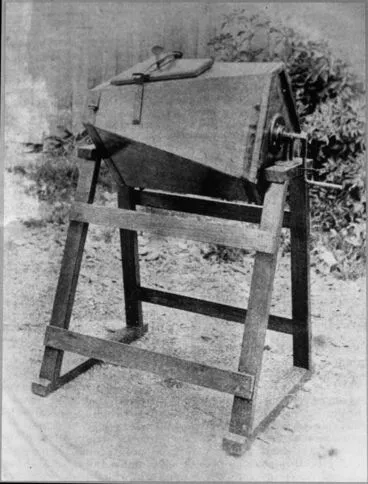



![[untitled figure] - Settler Kaponga 1881–1914 — A Frontier Fragment of the Western World Image: [untitled figure] - Settler Kaponga 1881–1914 — A Frontier Fragment of the Western World](https://thumbnailer.digitalnz.org/?resize=770x&src=https%3A%2F%2Fndhadeliver.natlib.govt.nz%2Fwebarchive%2F20201108000000mp_%2Fhttp%3A%2F%2Fnzetc.victoria.ac.nz%2Fetexts%2FArnSett%2FArnSett136b.jpg&resize=368%253E)









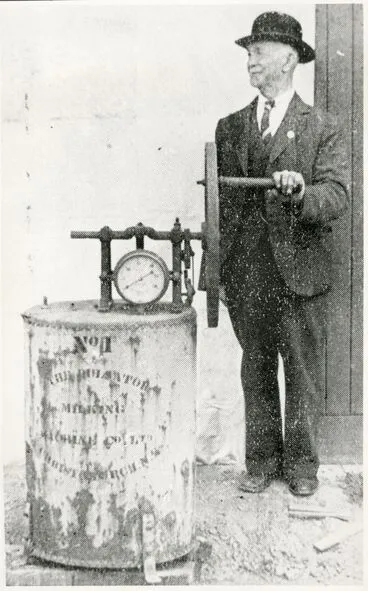













































![Photograph, 7 of 19, Mataura Dairy Factory Album [Farmers' Trucks] Image: Photograph, 7 of 19, Mataura Dairy Factory Album [Farmers' Trucks]](https://thumbnailer.digitalnz.org/?resize=770x&src=https%3A%2F%2Fimages.ehive.com%2Faccounts%2F4033%2Fobjects%2Fimages%2Fhgsk54_3q7c_l.jpg&resize=368%253E)







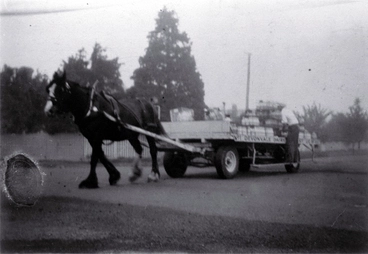
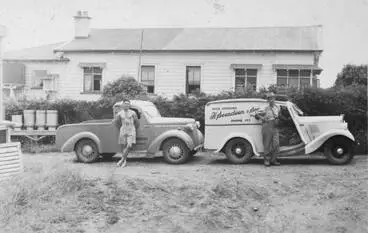








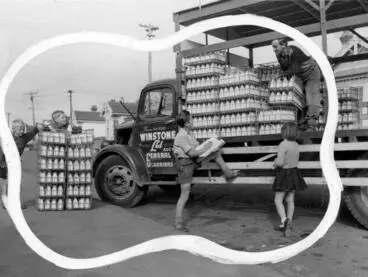





!["The Old And The New" [Tanker] Image: "The Old And The New" [Tanker]](https://thumbnailer.digitalnz.org/?resize=770x&src=https%3A%2F%2Fdtq0471jmmy9v.cloudfront.net%2Fiiif%2F2%2Fcurtis-production2-cache%252F1%252F6%252Fe%252F9294b6-0678-4c59-ac03-0342188ef6d6%252Fresize_master_95e8d34f46c946cbf8566fffc5010250.jpg%2Ffull%2F%21880%2C1024%2F0%2Fdefault.jpg%3Fsig%3D1ec357a276f04a5a6a17564b3f870b7e5b342145%26ver%3D1655564180&resize=368%253E)





